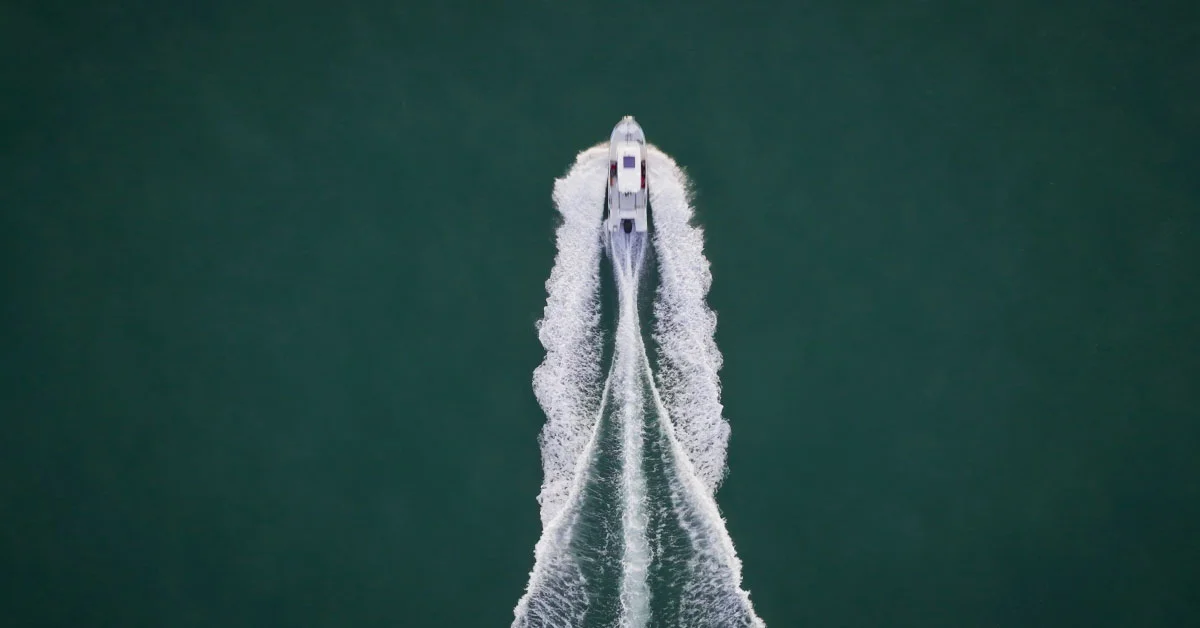Here is the incredible story of catching 4 cod records in France and 1 cod record in Europe in a single day! It was March 20, 2011. I was presenting my latest soft lures for cod and pollack in the store. The next day, I set out to practice, far from imagining that a day of record-setting cod fishing awaited me!
During winter, I particularly target two species: pollack and cod, commonly known as morue in France. Both these species can reach sizes surpassing that of sea bass, with some individuals exceeding 10 kg in weight in their later years. What fascinates me most in fishing is quality over quantity. That year, I had caught an 8.4 kg pollack in February and assumed that would be it for catching large winter fish. However, against all odds, the sea turned out to be favourable, offering me an exceptional day with record-setting cod. Here is the story of that incredible day.
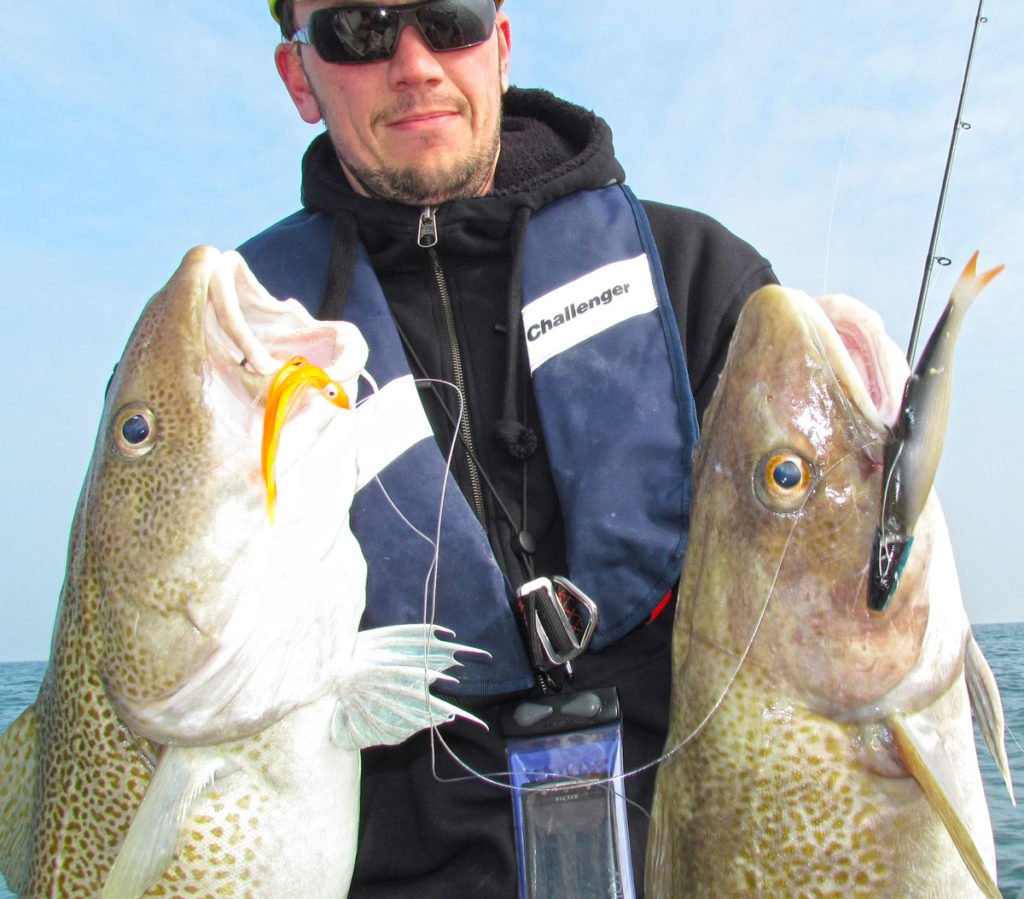
Choosing deep waters to target cod
Departing from Boulogne-sur-Mer, I primarily sought cod, more commonly known as morue in the northern part of France. In 2011, I was living in Bordeaux for the development of products for the Sakura brand. Suffice to say that I had lost sight of this cold-water fish. I sought information, but the reports were very bleak. Both from professional fishermen and recreational anglers, cod were scarce that winter. Indeed, during the winter of 2011, cod were desperately absent. But that didn’t discourage our small team consisting of Thomas and Didier, two childhood friends. When the first break in the weather of that month was announced, it was a pleasure not to be missed. I was determined to head out to sea, at the very least to get some fresh air.
We headed towards the deep waters likely to hold cod towards the end of winter. We were in the rising current of the Pas-de-Calais Strait, an area called the “freight highway.” Here, the traffic is the busiest in the world. To find cod in this vast area, there are two options. Either fish around a wreck or explore a sediment-rich area abundant in food. With these historically high tide coefficients of 118, wreck fishing was challenging. Therefore, I chose a fishing area indicating sediment “bkSh.” This abbreviation stands for “broken Shells,” a literal translation of “broken shells.” These molluscs attract brittle stars, similar to starfish, which adult cod love.
By the way, these large cod specimens make short work of any fish in their path. They devour herring, whiting, whiting pollock, and flatfish like candy.
The cod kept us anchored at the bottom on the 1st drift
The first drift set the tone: a significant bottom detection appeared on the sounder. Bingo, the rods bent to the maximum. It’s heavy, it’s definitely cod! The beautiful cod kept us anchored to the bottom, ascending only centimetre by centimetre!
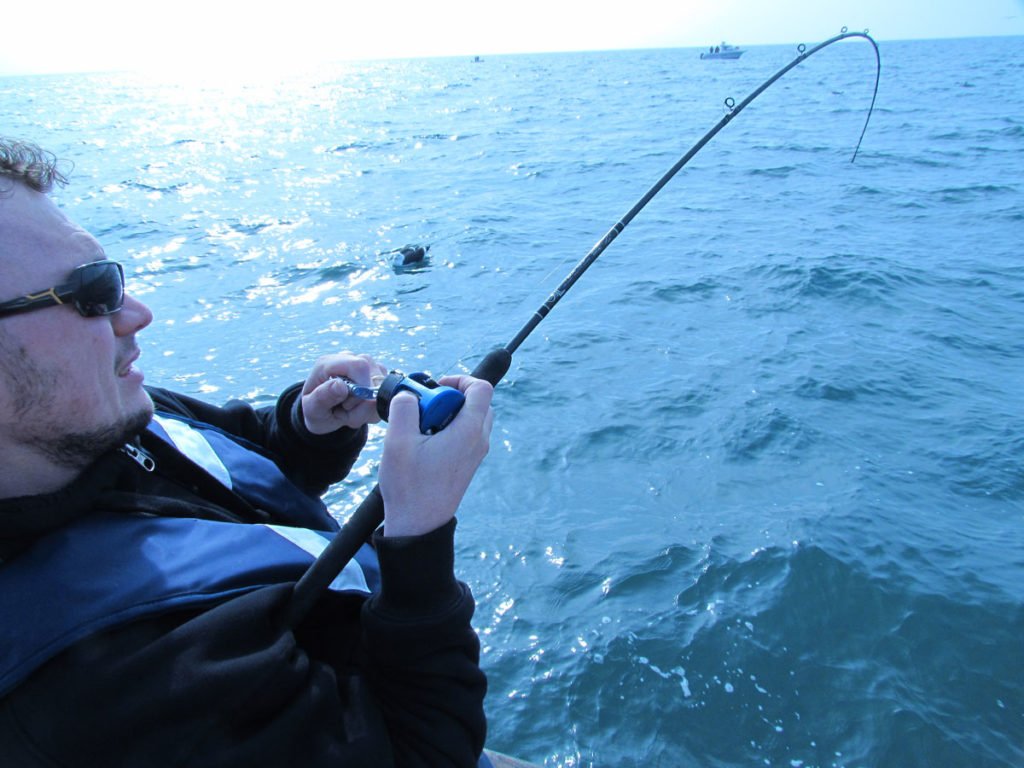
Thomas and I each reeled in cod weighing over 6 kg on large lures. Meanwhile, Didier brought up a small cod of 1.5 kg caught on a slug, a rubber lure. It’s small, yet cod usually favour sand eel. Not today! Our predator was focused on herring. Thus, as the drifts continued, we quickly understood that to target large fish, we needed large, lifelike lures. At least, we needed lures that matched the morphology of herring. So, slowly but surely, we brought up specimens of over 6 kg on our soft lures. Meanwhile, the three other boats present in the area didn’t catch anything. They were using old-fashioned 250 to 500 g spoons.
Light equipment from rod to lure
To target the large cod present at the bottom, we needed large, minimally weighted lures. Lures measuring 15 to 20 cm, quite bulbous, with a lead head weighing 75 to 125 grams. To benefit from the volume of the shad without the vibrations that slow down the descent into the deep, you can cut the tail fin.
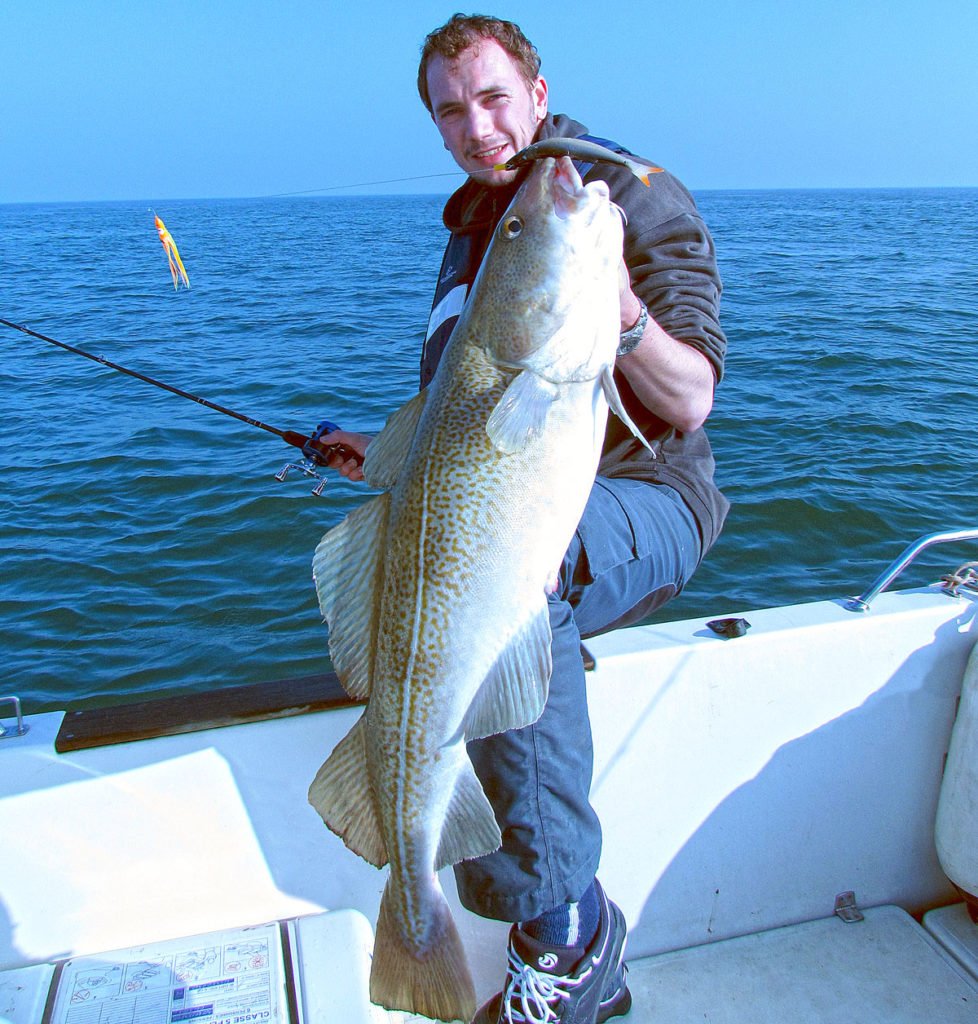
The rods used were high-quality carbon, with a minimum price of 150 euros for adequate action. Their length ranged from 1.90 to 2.25 m, with a medium casting power of 20-85 g and reels sized 4000 to 5000 spooled with 0.18 to 0.23 mm braid.
I also used bait-casting equipment for optimal sensations that day.
A Celebration of record-setting cod averaging 6.5 kg!
What a contrast between the heavy spoons used by the other boats and our soft lures on light lines. While the neighbouring boats caught nothing, I had a celebration of enormous fish with 4 French cod records and one European record: 6.845 kg, 6.855 kg, 9.060 kg, and 10.190 kg, respectively caught on 0.20, 0.10, 0.38, and 0.14 mm lines. We reached the quota with an average weight of 6.5 kg per cod!
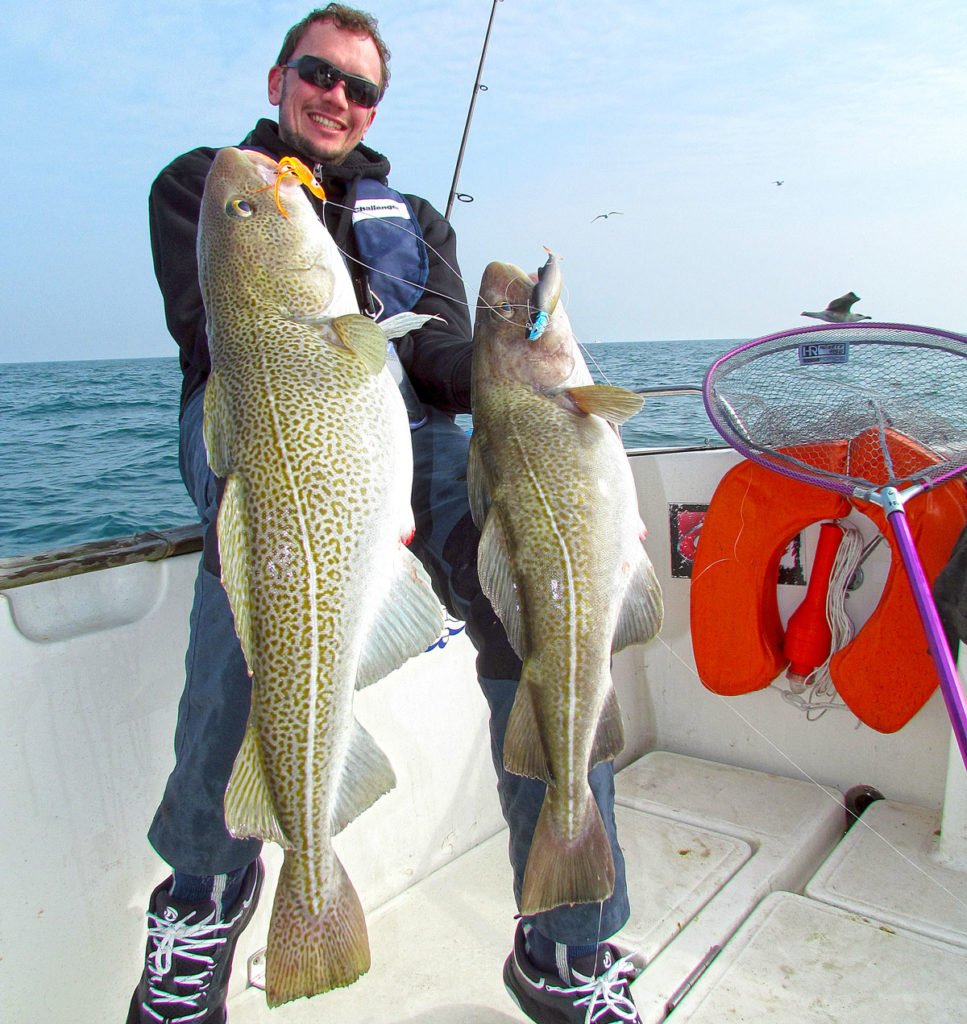
Record-setting cod thanks to light equipment
I approached one of the boats whose captain had bought equipment from me the day before. On my advice, he had purchased a whole set of gear for cod fishing from the store: a rod, a reel, 0.16 mm braided line, soft lures, and lead heads. A nice kit to be operational. I pointed out the lures that worked, but he surprised me by stating that he hadn’t taken any of his purchases from the day before. Eventually, I realized that I had been a good salesman; he was convinced by my stories but didn’t believe in them enough. He was using his usual rods, which are often referred to as broomsticks nowadays.
Given the heaviness of his rod and line, I entrusted him with the heaviest gear I had: a 15 cm shad with a 125 g lead head. In one drift, he caught a beautiful 6 kg cod. Phew, that cod saved him from returning empty-handed! An experience our friend won’t forget. By the way, the three boats fishing “the old way” with heavy gear confirmed the importance of light equipment to target these record-setting fish actively feeding on herring. A hovering soft lure imitates herring better than a 300 to 400-gram spoon.
Cod or Codfish, a story of conservation
In the past, post-war professional fishermen didn’t have ice on board their boats. They weren’t bound by quality standards. Their best method for preserving fish was salt. This allowed them to preserve cod for a month in the trawler. It was a blessing at that time! Cod was stored in separate rows with coarse salt. The cod, preserved and then dried, became known as haddock. Colossal quantities of salted cod were brought to the coast and sold at very low prices. That’s why it was called the “poor man’s fish” in Northern France.
Conservation methods have evolved, but haddock is still sold salted today. Cod is still commonly referred to as haddock. The image of the “poor man’s fish” stuck with it for a long time. But nowadays, Codfish has become scarce and almost a noble fish. Cod loin sells for a high price! Fresh cod, gutted at sea and boiled within 1 to 4 days after fishing, makes an exquisite dish. If it exceeds 2.5 kg, the remaining broth can be used to make a gratin. It’s one of my favourite fish, and its taste has nothing to do with the salted cod that is still sold today. If unable to catch it, it’s possible to find it in good condition at fish markets or directly from professional fishermen at their stalls.
To be correct, I could have used “cod” throughout the story. But the term “Codfish” is much more widespread in the jargon of both professional and sport fishermen. Naturally, that’s how I prefer to refer to this fabulous fish.

